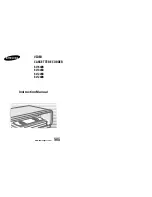
1-4
1.4 Service position
This unit has been designed so that the Mechanism and
Main board assemblies can be removed together from the
chassis assembly. Before diagnosing or servicing the cir-
cuit boards, take out the major parts from the chassis as-
sembly.
1.4.1
How to set the “Service position”
(1) Refer to the disassembly procedure and perform the dis-
assembly of the major parts before removing the Drum
assembly.
(2) Lower the cassette holder to prepare for the removal of
the Mechanism assembly screws. (Refer to the “Proce-
dures for lowering the Cassette holder assembly” of 1.3
Disassembly/assembly method.)
(3) Remove the combined Mechanism and Main board as-
semblies.
(4) If any other major parts are used, remove them also.
(5) Connect the wires and connectors of the major parts that
have been removed in step (1) to (4). (Refer to Fig.1-4-1a.)
(6) Place the combined Mechanism, Main board and other
board assemblies upside down.
(7) Insert the power cord plug into the power outlet and then
proceed with the diagnostics and servicing of the board
assembly.
Notes:
• Before inserting the power cord plug into the power
outlet, make sure that none of the electrical parts are
able to short-circuit between the workbench and the
board assembly.
• For the disassembly procedure of the major parts and
details of the precautions to be taken, see “1.3 Disas-
sembly/assembly method”.
• If there are wire connections from the Main board and
Mechanism assemblies to the other major parts, be
sure to remove them ( including wires connected to the
major parts ) first before performing step (2).
• When carrying out diagnosis and repair of the Main board
assembly in the “Service position”, be sure to ground
both the Main board and Mechanism assemblies. If they
are improperly grounded, there may be noise on the play-
back picture or FDP counter display may move even
when the mechanism is kept in an inoperative status.
• In order to diagnose the playback or recording of the cas-
sette tape, set the Mechanism assembly to the required
mode before placing it upside down. If the mechanism
mode is changed (including ejection) while it is in an up-
side down position the tape inside may be damaged.
1.5 Mechanism service mode
This model has a unique function to enter the mechanism
into every operation mode without loading of any cassette
tape. This function is called the “Mechanism service mode”.
1.5.1
How to set the “Mechanism service mode”
(1) Unplug the power cord plug from the power outlet.
(2) Connect TPGND and TP7001(TEST) on the board as-
sembly with a jump wire. (Refer to Fig.1-4-1a.)
(3) Insert the power cord plug into the power outlet.
(4) With lock levers (A) (B) on the left and right of the Cas-
sette holder assembly pulled toward the front, slide the
holder in the same direction as the cassette insertion di-
rection. (For the positions of lock levers (A) (B), refer to
the “Procedures for lowering the Cassette holder assem-
bly” of 1.3 Disassembly/assembly method.)
(5) The cassette holder lowers and, when the loading has
completed, the mechanism enters the desired mode.
1.6 Jig RCU mode
This unit uses the following two modes for receiving remote
control codes.
1) User RCU mode : Ordinary mode for use by the user.
2) Jig RCU mode
: Mode for use in production and serv-
icing.
When using the Jig RCU, it is required to set the VCR to
the Jig RCU mode (the mode in which codes from the Jig
RCU can be received). As both of the above two modes
are stored in the EEPROM, it is required to set the VCR
back to the User RCU mode each time that an adjustment
is made or to check that the necessary operations have
been completed. These modes can be set by the opera-
tions described below.
1.6.1
Setting the Jig RCU mode
(1) Unplug the power cord plug from the power outlet.
(2) Press and hold the “REC” and “PAUSE” buttons on the
VCR simultaneously, while plugging the power cord plug
into the power outlet.
When the VCR is set to the Jig RCU mode, the symbols
( “ : ” ) in the time display of the FDP are turned off.
1.6.2
Setting the User RCU mode
(1) Turn off the power.
(2) Press the “REC” and “PAUSE” buttons of the VCR si-
multaneously. Alternatively, transmit the code “80” from
the Jig RCU.
1.7 Servicing items related to video navigation
The video navigation function built into this unit works by
storing the video navigation data in the internal EEPROM
and writing data in the cassette tape simultaneously.
The video navigation data stored in the EEPROM cannot be
copied to another EEPROM. Therefore, when the circuit board
mounting the EEPROM is replaced, the original EEPROM
should be mounted on the new board. This will make the us-
er’s video navigation data usable with the new circuit board
after replacement. However, the user’s data cannot be restored
if the EEPROM on the original circuit board is damaged.
Note:
• If the circuit board mounting the EEPROM or the
EEPROM alone has been replaced, it is required to per-
form confirmation/re-adjustment on all of the adjust-
ment items using the EVR as well as those which are
adjusted by transmitting adjustment codes from the Jig
RCU.
Fig. 1-4-1a
CP3002
CP4001
TP7001
TEST
CN7001
CN916
TPGND
TP2253
A.PB.
FM
TP4001
CTL. P
TP106
PB. FM
TP111
D.FF
Main
board
assembly
VR1201
D/A LEVEL ADJ
C3025
Timer Clock
ADV. Jog board
assembly
2D Digital board
assembly
Demodulator board
assembly
S Jack board
assembly
Terminal board
assembly
Summary of Contents for HR-S5900AM
Page 6: ......
Page 10: ......
Page 42: ...VICTOR COMPANY OF JAPAN LIMITED VIDEO DIVISION Printed in Japan S40894 ...
Page 82: ......


































